Background: Study Justification and Knowledge Gap Identification
People buy cars for various reasons: some do it to confirm their social and economic status, and others do it to address personal or business-related transportation needs. However, given the numerous car brands, models, and shapes, selecting one option is never an easy undertaking. The Ford Fiesta was the bestselling vehicle in the United Kingdom in 2019 (The UK’s top 10 bestselling cars, 2020). Looking at the number of registered cars in the United Kingdom from January 1, 2019, to December 31, the same year, there were 77,833 new registrations of the Ford Fiesta (The UK’s top 10 bestselling cars, 2020). It was followed closely by the Volkswagen Golf (with 58,994 registrations), Ford Focus (56,619 registrations), Vauxhall Corsa (54,239 registrations), and the Mercedes Benz A-Class (54,724 registration) (The UK’s top 10 bestselling cars, 2020). Out of the top five cars of 2019 in the UK, three were manufactured by Ford, indicating that more customers preferred a Ford to any other vehicle brand.
In the proposed study, the author will investigate some of the reasons contributing to such a purchase. Its outcomes could be useful in informing strategic decisions, particularly about car marketing. The research will also address the common misconception that the most important factor in making a car purchase decision is the price. The proposed research might also help struggling car manufacturers develop and implement a better strategy to enhance their sales in the future. Possibly, the main reason for the existence of struggling car manufacturers in the UK is a lack of an understanding of the customer purchasing decision. Indeed, nobody fully understands the process, especially because customer needs and preferences may change from time to time. Without a doubt, the process of buying a car is complex, and customers consider various factors beyond price.
Although researchers have conducted studies on general factors that affect purchase decisions, few of them (if any) look at customer car purchasing decisions in the United Kingdom. Given that the UK is among the five biggest car manufacturers in Europe and a notable exporter of cars, understanding local dynamics will create a clear picture for the automobile industry in the country and help its improvement. The absence of enough studies about the factors affecting car buying intention among UK customers is the justification for this study. As note earlier, a gap exists in the research about the issues that customers consider before buying a car in the UK. Existing studies do not examine the role of a car’s technology, brand, performance, maintenance costs, perceived quality, spare parts availability, price, and resale value on the purchase by a UK customer. Thus, another purpose of the proposed study would be to bridge this research gap.
Research Aim and Objectives
The research’s main aim is to understand the factors that influence a UK buyer’s decision to purchase a vehicle. The research will focus on how the car’s brand, technology, perceived quality, performance, maintenance costs, spare parts availability, resale value, and price influence the purchase decision. The specific research objectives that would guide and direct the study include the following:
- To understand the impact of a car’s brand on a UK customer’s purchase decision
- To understand the impact of a car’s technology on a UK customer’s purchase decision
- To understand the impact of a car’s perceived quality on a UK customer’s purchase decision
- To understand the impact of a car’s performance on a UK customer’s purchase decision
- To understand the impact of a car’s price on the UK customer’s purchase decision
- To understand the impact of a car’s maintenance costs on the UK customer’s purchase decision
- To understand the impact of a car’s spare parts availability on the UK customer’s purchase decision
- To understand the impact of a car’s resale value on the UK customer’s purchase decision
Research Questions
For the proposed study, the researcher will design research questions based on the goal and objectives of the study. Therefore, the main research question is: what factors affect or influence a UK buyer’s decisions to purchase a vehicle? Specific research questions that the author will use to conduct the study include the following:
- What is the impact of a car’s brand on a UK customer’s purchase decision?
- What is the impact of a car’s technology on a UK customer’s purchase decision?
- What is the impact of a car’s perceived quality on a UK customer’s purchase decision?
- What is the impact of a car’s performance on a UK customer’s purchase decision?
- What is the impact of a car’s price on the UK customer’s purchase decision?
- What is the impact of a car’s maintenance costs on the UK customer’s purchase decision?
- What is the impact of a car’s spare parts availability on the UK customer’s purchase decision?
- What is the impact of a car’s resale value on the UK customer’s purchase decision?
UK Car Industry Background
Gross Value Added
The UK car industry includes the manufacturer of vehicles, parts, bodies, and trailers. In 2018, the industry added £16.6 to the economy, which was one percent of the total output of the UK economy and 8 percent of the manufacturing sector’s output (The motor industry: Statistics and policy, 2019). As shown in Figure 1, the industry’s output for the two decades leading up to the 2008 financial crisis was largely flat, before dropping sharply in 2009 and bouncing back strongly in 2010, from where it grew steadily until 2016 (The motor industry: Statistics and policy, 2019). Compared to the previous year, the 2017 output of the industry flat, and in 2018, for the first time since 2009, the industry’s output fell by 2 percent (The motor industry: Statistics and policy, 2019). In 2018, the industry’s output as a percentage of the manufacturing sector was 8.4 percent, up from 6.3 percent in 2002 (The motor industry: Statistics and policy, 2019). The industry plays a critical role in the country’s economy despite changes in output over the years.
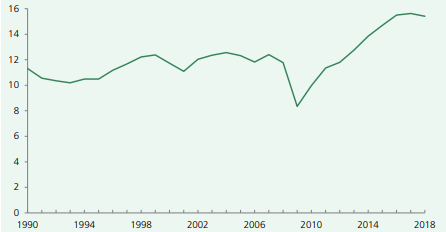
Employment
The industry employs thousands of people both directly and indirectly. In 2018, 166,000 people worked directly in the motor vehicle manufacturing industry, representing 1 percent of all employees and seven percent of those working in the manufacturing sector (The motor industry: Statistics and policy, 2019). The current number of employed individuals in the car industry is lower than several decades ago. For example, the industry directly employed 500,000 people in 1971 (The motor industry: Statistics and policy, 2019). The reduction in employees is due to the growth of other industrial bases in the Far East, coupled with improvements in productivity. These changes have also led to employee turnover in other manufacturing sectors. However, the manufacturing sector has had episodic growth in the number of employed individuals. As shown in Figure 2, the 2011 to 2015 period is a case example of this occurrence, where, for the first time in two decades, employment in the sector grew before plummeting in 2017 and rising again in 2018.
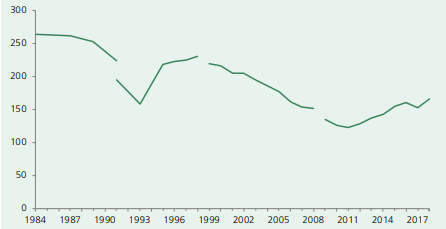
Vehicle Production
The number of vehicles and related parts produced in the UK varies from one year to another, depending on demand and other economic, social, political, and environmental factors. In 2018, UK car manufacturers produced 1.60 million vehicles, 1.52 of which were cars, and the rest were commercial vehicles such as vans (The motor industry: Statistics and policy, 2019). At 2.3 million units, vehicle production in the United Kingdom peaked in 1972 (see Figure 3) before production fell throughout the remainder of the 1970s, only increasing again in the second part of the 1980s and for most of the 1990s (The motor industry: Statistics and policy, 2019). Part of the reason for an increase in vehicle production in the UK was the setting up of manufacturing plants in the country by foreign firms. For example, the Japanese car manufacturer Nissan opened a production facility in Sunderland in 1986. Car and commercial vehicle production in the UK fell in 2009 due to the 2008 financial crisis. Production increased and exceeded the 2007 pre-crisis level in 2016 and fell in the following two years. Today, the UK continues to produce fewer units than it did in the 1990s, and commercial vehicle production is yet to recover from its steep decline in 2009.
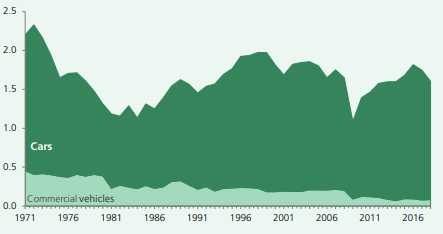
Vehicle Production in Other European Union Countries
The leading car producer in the European Union is Germany. In 2018 alone, the country produced 5.1 million units, more than thrice as much as the UK’s output (The motor industry: Statistics and policy, 2019). Spain and France produced 2.3 and 1.8 million units respectively in 2018, as shown in Figure 4. From the recent statistics, although car production in the UK is reducing compared to a few decades ago, the country is still among the top five producers in the European Union.
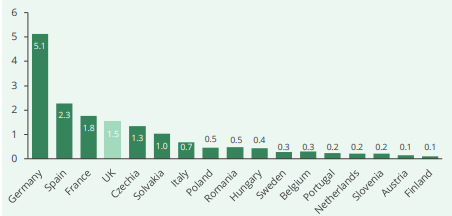
Car Registrations
The number of car registrations – indicating ownership trends – has been fluctuating over the years in the United Kingdom. For example, new registrations of vehicles in the United Kingdom dropped from 2.6 million in 2003 to 2.0 million in 2009 (The motor industry: Statistics and policy, 2019). New registration numbers recovered thereafter, with 2.7 and 2.4 million being recorded in 2016 and 2018, respectively (see Figure 5).
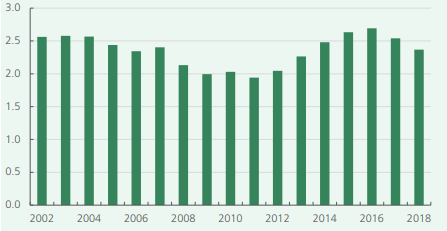
Brexit
There is a high integration of the UK vehicle industry with the remainder of Europe. Thus, the UK’s decision to leave the European Union led to concerns about the potential negative impact, with some stakeholders arguing that the move has no advantages for the automotive industry for the foreseeable future. Some of the key issues that Brexit raised for the automobile industry include tariff barriers and non-tariff barriers such as delays, regulatory standards, and labor market issues. In 2018, the UK exported 8 out of 10 manufactured cars, with 53 percent of these exports going to other EU markets. In the absence of an express trade deal, participants will conduct UK-EU trade following the terms set out by the World Trade Organization (WTO). In this regard, a 10 and 4.5 percent tariff on vehicles and spares, respectively, will apply to UK exports to the EU and the rest of the world. According to the Society of Motor Manufacturers and Traders (SMMT), these tariffs would increase car production costs and undermine competitiveness.
Brexit would also affect the importation and exportation of car spares between the UK and the EU. The car manufacturing industry depends on the just-in-time model for the production of vehicles. This model means that manufacturers only buy the products and spares when a need for them arises. It saves on unnecessary inventory and additional costs. Depending on the deal between the EU and the UK, delays in acquiring sourced parts, or exporting them, will occur. This delay, coupled with cost increments caused by the tariff changes, would likely increase vehicle retailing prices and complicate further the customer’s purchase decision approach. The differing regulations affecting how manufacturers develop and test their vehicles will also complicate the car manufacturing process, which might trickle down to purchasers as increased costs, reduced options, and quality changes. Most importantly, the non-UK EU workers of the car manufacturing sector will be impacted by Brexit. If UK car manufacturers experience difficulty acquiring engineers, aerodynamicists, and other skilled workers with long-term training, education, and experience, the sector may offer reduced car options at higher prices.
UK Car Manufacturing Sector summary
The UK car industry is a crucial component of the country’s economy. It is worth more than £78.9 billion and directly employs more than 180,000 people in the manufacturing sector. The industry employs an additional 864,000 people across its broader domain (UK Automotive, n.d.). The industry also contributes 13 percent of the country’s total exports, earns the economy £44 billion annually, and spends £3 billion every year in research and development projects (UK Automotive, n.d.). The country has over 30 manufacturers that build more than 70 car models. These industries rely on the support of more than 2,500 component suppliers and some of the most skilled engineers in the world (UK Automotive, n.d.). The UK exports 8 out of the ten cars it manufactures to over 160 destinations worldwide. In 2018, the country built more than 2.5 million engines, 78,270 commercial vehicles, and 1.3 million cars (UK Automotive, n.d.). The industry is facing differing regulatory frameworks, including those surrounding Brexit. Car buyers in the UK may face reducing car options and higher prices given these recent and continuing industry changes.
The Need for the Study
Given the dynamic nature of the UK car sector, customers are facing new situations which are increasingly informing their decisions to buy a vehicle. The industry changes affect the decision concerning the car brand and model, car size, car shape, car manufacturing year, and car status (whether new or used). It also influences the customers’ decision to either buy a vehicle locally or source for one from a foreign manufacturer. Thus, the information from the research will help car dealers and possibly manufacturers examine their processes with a view of improving them in light of changing business conditions and customer likes and preferences. Because the goal of any business organization is to make profits, producing what the customer needs or wants is the way to achieving this goal. However, before a company can produce what the customer wants, it must understand how the customer thinks and makes decisions. This study will provide these manufacturers and their dealers or representatives across the UK insights into the car purchasing decision to help them optimize their businesses now and in the future.
Research Methodology: Quantitative Research
Because one of the purposes of the proposed study is to generalize the results back to the population, the author will conduct quantitative research. Data will be collected through surveys created with the help of Survey Monkey – an online tool for developing questionnaires. Survey Monkey will also help the researcher to distribute the online questionnaires to the participants, collect the results, and conduct preliminary analysis. The questionnaires will contain closed-ended questions to make it easy for the researcher to compare the results from different participants. Although close-ended questionnaires limit the participant’s answers and ability to express themselves fully, it allows for easier comparison of responses, thereby allowing the researcher to apply various statistical data analysis methods on the data.
Notably, statistical methods place emphasis on numbers as evidence for or against a given phenomenon. The use of numerical data reduces the time and resources needed to conduct the study, provided that it is arranged well. Survey Monkey helps in formulating the survey and arranging and analyzing the collected data, saving the researcher a significant amount of time and resources.
As noted earlier, quantitative research also facilitates the generalization of the research findings. Unlike qualitative studies, quantitative ones do not include information about personal opinions, feelings, and emotions. Instead, they reflect the general trends in the population. How representative of the population the selected sample is will influence the generalizability of the findings: the more representative the sample, the more generalizable the findings and vice versa.
Sampling Method: Systematic Sampling
The researcher will use random sampling to select participants for the proposed study. Therefore, all members of the population have an equal chance of being included in the upcoming research. The only criterion for inclusion is that one has to have bought a car within the past six months. Since there is no public data about people who have bought cars in the past few months, the researcher will approach at least five car dealerships in the country for a possible partnership in carrying out the proposed research. The author will get data of customers who recently bought a car from the dealership, and the researcher will give the dealership the final results of the study for their perusal and possible utilization.
Sample Size
Because this is quantitative research, the sample must be as representative of the population as possible. One way to achieve this is to utilize a big sample size, depending on the population. Thus, for the proposed study, the author would recruit at least 10,000 participants. All participants will be UK residents above the age of 18 and recent car purchasers. The researcher will not discriminate against possible participants on the basis of their race, gender, physical ability, religion, or sexual orientation. Any person meeting the inclusion criteria will be considered for the study.
Conducting the Study
The researcher will contact five car dealerships in the country and enter into an agreement for the research. It is easier for the researcher to get access to the customer data that car dealers have if the car dealership will also benefit from the research than if the dealership will not benefit. For the researcher to find a willing car dealership for the partnership, visits to many of them may be necessary.
Once the researcher has gotten access to the customer data, the next step will be developing the survey (questionnaire and questions) through Survey Monkey. Partnerships with senior researchers and faculty members in the London School of Business will be sought. These collaborations will lead to objective and non-personal research survey questions that customers will be comfortable replying to. The collaborations will also help identify and eradicate personal biases that may occur in creating the questions. The partners will also help the research to develop coherent and unambiguous questions that solicit clear answers. Novice researchers sometimes create ambiguous questions that confuse participants, and this can be avoided by involving more experienced and skilled researchers in the question formulation process.
After the research questions and the online survey are ready, the author will begin recruiting participants. As noted earlier, the author will only sample individuals who have actually bought a car within the last six months to increase the study’s objectivity, and by extension, its validity and reliability. Theoretically, individuals who have never bought a car could still provide critical insights about how they could go about it. However, those who have actually gone through the process have the real-life experience needed to make the proposed research authentic (i.e., valid and reliable). Because it is difficult to pick from the public people who have bought cars in the recent past, the only realistic way of doing that is partnering with car dealers to use their databases as the source of personal client information.
The author will access the data maintained by the partner car dealers and contact customers, one at a time, informing them about the research, its goals, and objectives, and inquire whether they will be willing to take part in the study. The researcher will not the details of the willing customers and agree on how the study will happen. The author will continue recruiting participants until the target of 10,000 participants is achieved. The researcher will then send the informed consent form for the participants to fill and return it. After receiving the duly filled consent forms from the participants, the researcher will send the participants the survey through Survey Monkey since the tool supports the use of emails to send questionnaires to participants.
Ethical Considerations
The general purpose of scientific research is the objective pursuit of the truth. Therefore, it is an important component in human life and in social, political, economic, and environmental issues. Maintaining ethical standards in research ensures that people continue to participate in the process and to offer critical insights that lead to the advancement of the existing body of scientific knowledge. For the proposed research, ethical considerations will encompass researcher-participant interactions, data handling and treatment, and reporting. The researcher will involve only those individuals meeting the inclusion criteria and be 18 years and above. The researcher will create a detailed consent form that shows the nature of the research and its purpose, scope, and other significant details. Potential participants will read this description of the proposed study before giving their informed consent. The researcher will carefully handle the client data, ensuring that it is sufficiently protected and that it does not get into the wrong hands. The researcher will protect the data by using computer systems with passwords and encryption keys.
The researcher will also maintain the confidentiality of the client information by not sharing it with third parties. Apart from that, the author will respect the diversity of the participants and treat them equally without any bias. When collecting data, the researcher will focus on getting information that will answer the research questions only. Care will be taken to avoid veering off from the main goal or asking irrelevant questions or questions that are too personal. The researcher will also handle the data carefully and examine it well to ensure that it answers the questions asked. No attempt will be made to alter the data so that the results could reflect the expected outcomes. The author will also report the findings objectively, even if they do not reflect the initial expectations.
Scope
The proposed study will be limited geographically to the United Kingdom, and the emphasis will be on the car purchase decision as influenced by car’s technology, brand, performance, maintenance costs, perceived quality, spare parts availability, price, and resale value. Limiting the scope of the study is necessary to ensure that the researcher completes it on time and within the budget.
Timescale
The proposed research will take about two months. Since this is an automated study (with Survey Monkey helping with data collection and analysis), the steps will take roughly ten days each. Thus, the researcher will complete the study towards the end of June if the study commences in the middle of May. Figure 6 below shows the study’s tentative timeline. Modifications may apply in the future when the study begins.

Reference List
The motor industry: Statistics and policy (2019) Web.
The UK’s top 10 bestselling cars of 2019 (updated) (2020) Web.
UK Automotive (n.d.) Web.